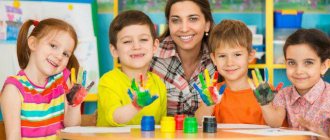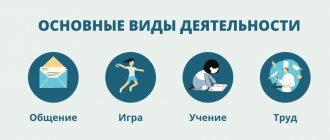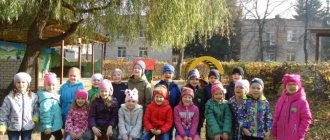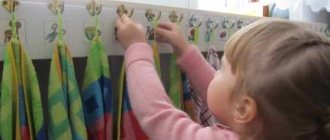Pedagogical supervision of a 3-4 year old child. Type of activity game
Pedagogical supervision of a child 3-4 years old
Pedagogical observation of a child during play activities
Author: Chernikova Natalya Valentinovna, teacher of MBDOU d/s No. 24 of the combined type “Polyanka”, Kstovo, Nizhny Novgorod region Description of the material: the material will be useful to educators, teacher-psychologists, parents for the purpose of observing the game a child of 3-4 years old, involving him in the process of play activities. Such pedagogical observation will help teachers assess the process of child development in the leading activity - play, and plan their further teaching activities. Goal: analysis of the formation of the play activity of a child of primary preschool age. Objectives: to encourage him to accept the task set by the teacher; enrich the content of play activities and the child’s play experience; promote the use of substitute objects, imaginary objects; form positive relationships between a child and an adult. Tools: doll, play corners in the group, toys (substitute items), table, sofa, knife, cutting board. Methods: questions, answers, game situation. Participants: teacher, child. Progress of pedagogical observation: /Dima has a pyramid ring in his hands, he spins it in front of him and moves aimlessly around the group, making one circle after another/
Educator: Dima, what are you doing? Dima: I'm driving. Educator: Do you have a car or a truck? Dima: I have a car. /the child can name the make of the car/ Educator: Where are you going? Dima: To the store. / if the child finds it difficult to answer, the teacher can offer to go to the store. You can come up with any other game situation, for example, going to the post office, to the laundress, to the pharmacy.
Depending on the game situation, the development of the game's plot will depend. /
Educator: What do you want to buy in the store? Dima: I'll buy candy. I love them very much. Teacher: /holds a doll in his hands/ The doll Katya and I also love candy very much. Will you treat us? Dima: Of course, I’ll treat you. /reaches the toy stand, pretends to buy candy, drives back/ Here are some candy for you. /unclenches his fist, puts imaginary candies on the teacher’s palm/ Teacher: /pretends to try the candy, treats the doll and thanks Dima/ Thank you, Dima. Tasty candy. Dima: / rejoices, volunteers to buy something else for the doll and the teacher / Now I’ll go to the store again and buy groceries. Educator: Very good. Katya and I will set the table. Please bring some bread and sausage. Dima: Wait. I quickly. /drives, but gets stuck on the way/ I ran out of gas. Need to refuel. /drives up to the FIZO corner, takes the jump rope, connects it to the car and refuels; then he goes to the store, stops near the shelf with toys, thinks, chooses a brick and a cylinder, and goes back; Another situation may happen, for example, the car may get stuck on the road or break down.
Depending on the current situation, the child’s actions will depend /
Educator: Dima, what happened to you on the way? You were away for a long time. Dima: The car ran out of gas. I stopped at a gas station and filled the car with gasoline. Educator: Did you remember to buy groceries? Dima: Yes, I bought bread and sausage / hands the teacher a brick and a cylinder / Teacher: Well done! Let's have dinner now. /cuts bread and sausage/ Go, wash your hands, sit down at the table. /have dinner/
We recommend watching:
Master class for teachers Role-playing game in the younger group. Daughters - mothers Games for the development of sensory analyzers for children 3-4 years old Collective games for children of the younger group (3-4 years old)
Similar articles:
Educational games for children 3-4 years old in kindergarten
Games to develop communication for preschoolers
Games for the development of speech and thinking for children 3-4 years old in kindergarten in a group
Outdoor games for children 3-4 years old in kindergarten
Summer games for children 3-4 years old in kindergarten
Observation of the teacher's work
The number of characteristics studied should be minimal and they should be precisely defined. The more detailed the questions about the characteristics being studied are formulated and the more accurately the criteria for assessing these characteristics are defined, the greater the scientific value of the information obtained.
Psychological and pedagogical phenomena should be observed in real natural conditions.
The observer must know in advance what errors can be made during observation and prevent them.
Particularly important is the careful development of the observation scheme,
it could be as follows:
1) a problematic situation is identified,
2) goals and objectives are determined,
3) the object of observation (individuals or a group), the subject of observation (the behavior of an individual or group), and observation situations are determined;
4) the method of observing and recording data is selected;
5) an observation plan is constructed (situations - object - time);
6) a method for processing the results is selected;
7) observation is carried out according to the plan;
 processing and interpretation of the received information is carried out.
processing and interpretation of the received information is carried out.
Methods for recording observation results
Principles of observation:
Observations in different types of activities: in situations where children use cultural and hygienic skills and self-care skills; in situations of gaming activity; on a walk; in an educational situation; when experimenting; in a corner of nature; in GCD; when carrying out orders; during children's parties; when children communicate with their parents. etc.
The observation method refers to less formalized monitoring methods. These methods provide very valuable information about the child, especially when the subject of study are phenomena that are difficult to objectify (for example: value orientations, the child’s attitude to various phenomena) or are extremely variable in content (dynamics of goals, states, moods, etc. .). Semi-formalized methods are very labor-intensive. Only the presence of a high level of observation culture helps to avoid the influence of random and collateral factors on the survey results.
-Dear Colleagues! I propose to end the consultation with the game “Find the Three Differences.” We understand perfectly well that person-oriented communication is not possible without taking into account the individual characteristics of the child. The main method that allows us to identify these features is OBSERVATION.
GAME “FIND THREE DIFFERENCES”.
Instructions: stand opposite each other, for one minute the partners look at each other carefully, trying to remember the appearance of their “couple”. Then the players of one line turn away, and each participant of the second line changes three signs in their appearance over a certain time (for example, removes scarf, exchanges earrings with a neighbor, puts on gloves, etc.). When the players in the first rank turn to face their partners, the task of each of them is to determine what has changed. Then the players change roles.
When to start observation and what is its main value?
Observation is important at any age. Children under 3 years of age are just learning to speak, so we cannot get full feedback from them. And after 3 years, children act largely unconsciously - they cannot understand themselves and tell us about their motives and needs.
By observing, we can figure out what is really happening to the child. Why does he cry, what makes him happy and upset. What is interesting for him, what is difficult and what is easy. How he copes with difficulties and finds solutions to new problems. What he is just learning, and what he is ready to do himself.
In Montessori pedagogy, we often talk about observation, because the entire methodology is based on it. With the correct technique of observing a child, we can understand him, see his age-related needs, and most importantly, discern his capabilities.
Mini-course on careful parenting “Without punishment”
Let's learn to set rules and boundaries without shouting and scandals
To learn more
Briefly about the main thing
- Observation is a tool that helps parents better understand their child's developmental needs.
- During observation, you should concentrate on the process and not be distracted by thoughts about other matters.
- When observing a child, we need to write down what we see, and not what we think about it.
- After observation, we draw conclusions and change the environment to suit the child’s needs.
Author: Olga Pichurina, head of Montessori and Montessori teacher AMI 0–3
Photo by Olga Goreva
Purpose: this method is indispensable for initial orientation to the reality of children's relationships. It allows you to describe a specific picture of the interaction of children, provides many living, interesting facts that reflect the life of a child in his natural conditions. Age : senior preschoolers (junior schoolchildren). Source: Smirnova, O.E., Kholmogorova, V.M. Interpersonal relationships of preschool children: diagnosis, techniques, correction. — M.: Humanitarian. ed. VLADOS center, 2005. - 158 p. (p.11-12)
Progress: the communicative development of children in the group and the characteristics of interpersonal relationships between children are monitored. When observing, it is necessary to pay attention to the following indicators of children’s behavior: initiative - reflects the child’s desire to attract the attention of a peer, to encourage joint activities, to express attitudes towards oneself and one’s actions, to share joy and sorrow, sensitivity to the influences of a peer - reflects desire and readiness the child to perceive his actions and respond to suggestions. Sensitivity is manifested in the child’s actions in response to requests from a peer, in the alternation of proactive and reactive actions, in the consistency of one’s own actions with the actions of another, in the ability to notice the wishes and moods of a peer and adapt to him; the prevailing emotional background is manifested in the emotional coloring of the child’s interaction with peers: positive, neutral-business and negative. A protocol is created for each subject, in which, according to the diagram below, the presence of these indicators and the degree of their severity are noted. Scales for assessing parameters and indicators. Criteria for assessing parameters: Initiative: - absent: the child does not show any activity, plays alone or passively follows others - 0 points. - weak: the child is extremely rarely active and prefers to follow other children - 1 point. - average: the child often shows initiative, but he is not persistent - 2 points; - the child actively attracts surrounding children to his actions and offers various options for interaction - 3 points. Sensitivity to peer influences: - absent: the child does not respond to peer suggestions at all - 0 points. - weak: the child only rarely reacts to the initiative of peers, preferring individual play - 1 point. - average: the child does not always respond to suggestions from peers - 2 points. - high: the child responds with pleasure to the initiative of peers, actively picks up their ideas and actions - 3 points. Predominant emotional background: negative - 0-1 points; neutral-business - 2 points; positive - 3 points. Calculation of the level of development of a preschooler’s communicative qualities: Registration of children’s behavior using this protocol will make it possible to more accurately determine the nature of the child’s relationship with peers. The sum of points for all criteria allows us to assess the level of development of preschoolers’ communicative qualities: 0-3 points - low level, absence or weakly expressed initiative may indicate an underdeveloped need to communicate with peers or an inability to find an approach to them. Lack of sensitivity to peer influences, a kind of “communicative deafness,” indicates an inability to see and hear another, which is a significant obstacle in the development of interpersonal relationships. Negative emotional background. 4-6 points - average level, indicates a normal level of development of the need for communication, however, children may have complexes, fear, and embarrassment of communication with peers. The emotional background is neutral and businesslike. 7-9 points - a high level indicates a high level of children’s need to communicate with peers. Positive emotional background. An important qualitative characteristic of communication is the prevailing emotional background. If a negative background (the child is constantly irritated, screams, insults peers, or even fights), the child requires special attention. If a positive background or positive and negative emotions towards a peer are balanced, then this indicates a normal emotional mood towards the peer. When observing, it is necessary not only to record children’s behavior according to the specified parameters, but also to notice and describe a living picture of children’s interaction. Specific statements, actions, quarrels, ways of expressing attention to a peer can provide irreplaceable real facts of a child’s life that cannot be obtained by any other methods.
| Download a ready-made calculation using this method | Order a ready-made calculation using this method | Ask us a question about this method |
At the moment, we do not have a ready-made calculation using this method; perhaps it will appear later. If you want to order an exclusive calculation using this method with your conditions or in combination with other methods, write to us by clicking on the second link. If you think that the methodology contains unreliable data or you have questions about conducting research on it, click on the third link.
Example of observation and interpretation of results
Child: Nastasya, 1 year 2 months Observation time: from 14:30 to 14:50 Observation location: living room and corridor
14:30 In hand, a soft toy, goes to the rocking horse, sits the soft toy down, it slides off, the baby repeats the action several times.
14:31 She tries to climb onto the rocking chair herself - it doesn’t work, she looks at her mother-observer, demandingly calls for help: “Ah-ah.” When mom doesn’t come up, she goes to her, hugs her, and starts muttering in her own language with notes of indignation.
14:33 He goes into the corridor, picks up the dog’s leash, twirls it in his hands, throws it on the floor, hears the neighbor’s dog barking outside the door, imitates: “Aw-aw.”
14:35 Returns to the room and sees a sheet of stickers on the floor. He picks it up and looks at it, imitating the sounds of the animals in the picture. He tries to peel off one sticker, accidentally tears the sheet, then continues to tear it on purpose.
14:37 He approaches his mother, tries to take away the pen with which mother takes notes, expresses dissatisfaction with sounds when he cannot take it away (mom gets up and walks away). He sits down on the sofa, starts biting his toe and frowns with a dissatisfied face. Throws a pillow from the sofa onto the floor, says: “Boom”, “Pa” (fell).
14:39 Gets off the couch, walks around the room, sees a book, sits down and starts leafing through it. Tries flipping from different sides.
14:40 Hears a dog barking, gets distracted, says “Aw-aw.” He returns to the book and hands it to his mother: “Ahh” (read it). Mom doesn't read - the baby leaves the book. He goes to the chair, takes his sippy cup, starts drinking, then bites the silicone spout. Returns to mom, asks for the breast, eats, then presses our lips to the breast, makes the sound “pr-r” - I like the sound effect, repeats it several times.
14:44 He goes to the dog, starts playing - taking the ball, in the process he imitates laughter: “Khi-khi-khi.”
14:45 He fails to get the ball, moves away from the dog, wanders around the room, repeats: “Prr-r-r”, babbles, tries different sounds, repeats: “Yes-yes-yes.” He approaches the dog’s bowl, begins to throw dry food, one piece at a time, into a cup of water, catches it, looks at it and touches it. Again he throws it into the water, takes it out, puts it in his mouth, spits it out and puts it in the water. He gets to his feet and tries to lift the cup, the water spills. Mom goes to eliminate the flood and stops watching.
Conclusions from observation:
- Imitates and repeats sounds, accompanies his actions and requests with speech → This means that you need to communicate more, read and sing songs, offer classes on onomatopoeia
- Moves a lot: climbs on and off the sofa, masters the rocking horse, bites his toes → We need to provide more opportunities for different movements on playgrounds or install a children's sports complex at home
- Explores different textures by touch and by teeth → Provide access to more objects made from different materials
- Makes “raids” to the dog’s feeding place and performs certain actions there → Try to recreate the same activity at the kitchen table: give the opportunity to apply, shift, taste, mix bran balls with water, fruit puree or pieces of fruit
- Tears stickers → Provide access to soft sheets of paper that can be torn
- Trying to lift a cup of water → Organize games with containers and water in the bathroom



